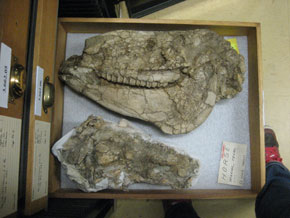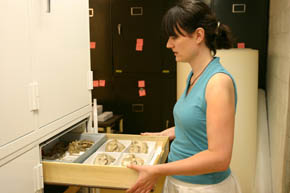Care
Because they have survived for millions of years, fossils may seem to be almost indestructible. In fact, they are just as vulnerable to damage as any other museum specimen and as examples of our local, national, or world heritage it is important that they be stored properly to ensure that they can be preserved for future generations to learn from and enjoy. Museums and universities invest a lot of time, effort, and money in ensuring that specimens are properly housed.
One of the best ways to ensure preservation of fossils is by providing a safe and secure storage environment. There are many different things that can be done. For a museum, it might involve the design of the buildings that are used to store fossils, or installing heating, ventilation, and air-conditioning (HVAC) plants to control the temperature and relative humidity of storage rooms. However, it also involves much smaller-scale, but equally important approaches, such as choosing archival materials for specimen boxes, trays, and labels, and using cabinets and boxes to create protective micro-climates.
The main challenge in storing fossil perissodactyls is size – large animals like rhinos, horses, and brontotheres can take up a lot of room and are very heavy. At AMNH, the perissodactyl collection occupies two whole floors of the museum’s Childs Frick Building – over 10,500 square feet of storage. In 2006, the Museum began work on a major project to upgrade storage of the perissodactyl collection, funded by the National Science Foundation. This involved the purchase of new specimen cabinets and heavy duty steel storage racks for specimens, together with construction of special housings for specimens to provide additional support and protection. You can read more about this project here.
Caring for collections means more than just physical care. As we discussed in the Finding section, much of the scientific value of specimens is tied up in the information that is associated with them: what they are, where and when they were found, and how they ended up in the museum. Cataloging is one of the first things that happens when a specimen is added to a museum collection. Labeling a specimen with a catalog number is a way of linking it to any paperwork or other data that provide information on its identity, history, or context. Historically, museum and university collections used ledger books, card catalogs, and paper files to store and track this information, but now most institutions use computer databases to manage and share information about their collections. Looking after this data is almost as big a task as looking after the specimens themselves.
The more information that is available about a specimen, the more useful it becomes. Not all of the available information about a specimen may have been captured in the catalog record – for example, a catalog may record the name of a fossil site, but not its exact location. By doing research on the collector’s fieldnotes, maps, and even their diaries and letters home, it may be possible to add this information to the catalog at a later date. This is a very time-consuming, but very important process. As part of the AMNH perissodactyl project, student interns went back through the museum archives to capture information that would improve the quality of the data about where the specimens came from. The interns wrote a blog about their experiences and you can read about what was involved by clicking here.



